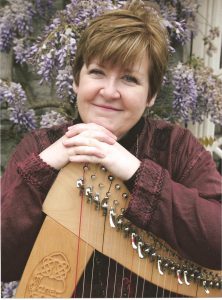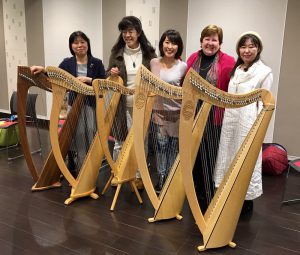Camac Blog
Janet in Japan, and…
Latest
September 3, 2018
Speaking of well-travelled Janets – the inspiration behind our Janet harp, Janet Harbison, hasn’t stopped since her trip with us to the Camac Festival USA. There’s been a sell-out concert with the Irish Harp Orchestra at Munich’s Gasteig, an extensive tour of Japan, two CD launches, courses, skype lessons, a lot of publishing…
Performer, teacher, composer and academic, Janet is famous throughout the Celtic harp world. She has won every national Irish harp competition (including the All-Ireland Championship), and a number of international prizes. Having been awarded a two-year Research Fellowship at the Institute of Irish Studies in Belfast, she spent eight years as Curator of Music at the Ulster Folk Museum. She founded the Harp Foundation Ireland, followed by the Irish Harp Centre. She is now Visiting Professor of (Irish) Music at the University of Ulster at Magee College, Derry.
In 2006, Janet published her ‘Harbison Harp Method’, which takes the oral method of teaching as its starting point. It’s a method intrinsic to Irish traditional music – in fact, as Janet writes in an interesting blog post about what traditional and classical musics can learn from each other, a millennium of Irish folk music only began to be written down from 1976.
“Learning by ear, before you see the script, gives students a more intuitive response”, Janet explains. “By which I mean, intuitive response to the music, and also to other people. When you’re playing in a group, you also need to be listening for leads and how they fit in. Also, getting rid of the sheet music releases people from the panic of seeing a difficult piece on paper – if there’s an unusual time signature for example, which looks daunting if you’re thinking you’re going to have to count it all. If you learn it by ear, then you’ll get it right much more naturally. Then, you can have the text to practice from at home, as an aide memoire but not as your starting point. Also, going back to the question of group work, because there’s no script leading the experience, I find that the ensembles often have a lot of freedom to be all things to all men. In my harp ensembles, I write different parts for different ability levels, and have more than one person on a part. Also, I make the distinction between Session and Stage play – one being more formal music preparation and the other for creative fun! For ‘Session play’, those who are feeling well at home with the part can improvise and go off into flights of fancy, while those who are less experienced can stay in their comfort zone. For ‘Stage play’ of course everyone is expected to stick to their parts! The oral method is dependant on the skill of the teacher leading the player(s), preparing new music by ‘breaking and building’ the phrases in a rhythmic repetition. In ensemble pieces, every part must be musically logical in itself to facilitate memorisation. Whether applied to harp solo or in an ensemble, the oral method is an organic way of learning – It’s not an anarchic “do whatever you like” experience, but rather a method that builds on intuitive musicianship.”
If you’re interested in the Irish harp, Janet’s new website offers a lot of fascinating material. You can explore her lectures, courses, concert programmes, Harbison Harp Method syllabus, workshops, a very extensive body of music, teaching material and recordings, and much more! The combination of a workshop with one of Janet’s virtuosic, lively and often sidesplittingly funny concerts is one we can particularly recommend.
At the Highest Concert in the World, Siobahn Brady is premiering ‘By Strangford Water’, a new work by Janet. “Strangford is the loch just south of Belfast”, says Janet. “It’s actually a tidal loch full of amazing wildlife, and it’s a protected world nature site. This tune was a gift for the eightieth birthday of my professor at the Institute of Irish Studies. He said that at the age of eighty, he wanted to sit in his chair peacefully and watch the tide ebb and flow, while waiting on the geese in the Spring. So this is about painting a picture of Strangford Loch in sound. It’s gentle water, and full of beauty, fertility and flow.” This piece will be the title track of Janet’s forthcoming album, that should be launched in October.


